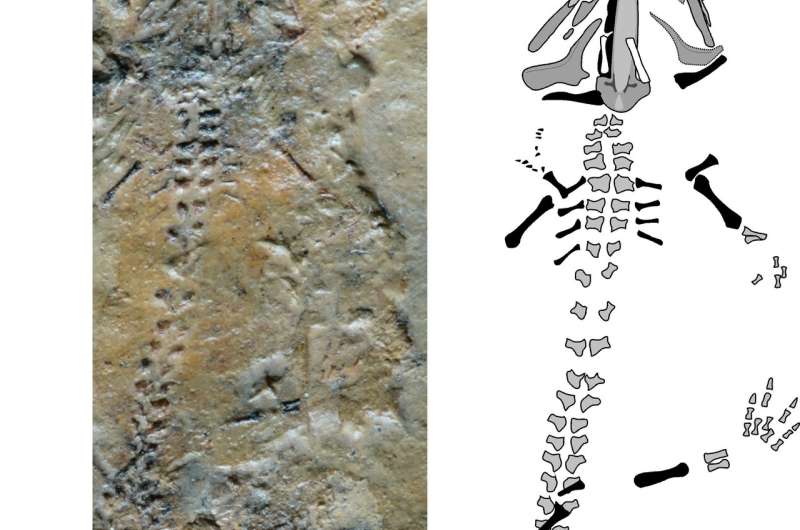May 12, 2020 report
Triassurus sixtelae fossil found in Kyrgyzstan is the oldest salamander ever found

Three researchers from Staatliches Museum für Naturkunde in Stuttgart, Naturhistorisches Museum Schloss Bertholdsburg and Urweltmuseum GEOSKOP/Burg Lichtenberg, all in Germany, have found the oldest salamander fossil ever uncovered. In their paper published in Proceedings of the National Academy of Sciences, Rainer Schoch, Ralf Werneburg and Sebastian Voigt describe their find and where it fits in the historical record.
The origin of amphibians is still mostly a mystery to scientists due to a variety of factors—their small size chief among them. It is still not known when they branched off from other tetrapods. In this new effort, the researchers have taken another step closer to finding out—their find, an ancient salamander species called Triassurus sixtelae, was from approximately 230 million years ago (during the Triassic)—the find is approximately 90 million years older than any other salamander fossil.
The fossil was excavated during a dig at the Madygen Formation in Kyrgyzstan—several years prior, an incomplete amphibian larva fossil had been found there. Then six years ago, the full (five-centimeter-long) skeletal fossil was found. It has been under study ever since.
Thus far, the researchers have been able to ascertain T. sixtelae was similar to many salamander species alive today in several parts of Asia. They have also found evidence that it lived on both land and in shallow water—near the shore of a freshwater lake. When it was alive, the area where it was found would have been part of the foothills of the Kyrgyzstan. The skeletal fossil's shoulder bones and palate and parts of its extremities served as evidence of its species. The team also found the fossil showed T. sixtelae had some differences from tetrapods that put it above temnospondyls on the evolutionary tree, in a group called batrachians, which includes salamanders and frogs in modern times.
The researchers suggest the find represents a bridge between the very oldest known salamanders and those that are still alive today. And the location of the find suggests that salamanders may have originated in Eurasia, and then dispersed widely from there, in some cases following land bridges that existed during the Triassic Period.
More information: Rainer R. Schoch et al. A Triassic stem-salamander from Kyrgyzstan and the origin of salamanders, Proceedings of the National Academy of Sciences (2020). DOI: 10.1073/pnas.2001424117
Journal information: Proceedings of the National Academy of Sciences
© 2020 Science X Network





















